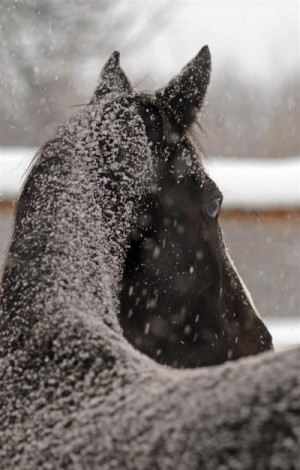
Kentucky Performance Products: The Horse’s Winter Coat
Learn more about how your horse thermoregulates.
Does your horse resemble a fluffy stuffed animal this time of year? That fluffy winter coat serves a very important purpose: keeping your horse warm. Thermoregulation is the process of controlling body temperature, and hair plays an important role. Each hair follicle has a small muscle controlled by the nervous system. Through a process called piloerection the nervous system pulls or puffs the hair up to increase airspace within the coat, thereby creating an insulating layer. It is your horse’s way of putting on a down jacket. Have you ever noticed that when it snows, snow sits on top of your horse’s long coat and doesn’t melt? The puffed-up hair creates a barrier to prevent heat from escaping the body. The outer layer prevents the snow from reaching the inner layer and melting.
Most horses handle winter temperatures without any problems. Horses will start feeling cold below certain critical temperatures. For a clipped horse, or one with a summer coat, the average critical temperature is 40°F. For horses with a thick winter coat, the critical temperature can be as low as 18°F. Wet horses are unable to maintain their body heat. Once a horse’s coat becomes wet, the critical temperature will increase by anywhere from 10°F to 15°F. For example, a dry horse will stay warm until the temperature goes below 18°F, while a wet horse will begin to get cold at 33°F.
Blanketing a horse with a good winter coat takes away the ability for the hair to stand up and provide insulation. In most situations it is not necessary to blanket them. If there is no shelter and a chance the horse will become wet (ice and/or freezing rain) a blanket will provide protection. Make sure the blanket is heavy enough to keep them dry and is put on while they are dry. Horses that are very young, very old, skinny, and/or not acclimated to the cold (e.g., moving from a southern to northern climate) may not grow adequate winter coats and will need blanketing.
Copyright (C) 2016 Kentucky Performance Products, LLC. All rights reserved.
Article sponsored by Ker-A-Form; a blend of vitamins, minerals, and fats that nourishes skin, hair coat, and hooves.
When health issues arise, always seek the advice of a licensed veterinarian who can help you choose the correct course of action for your horse. Supplements are intended to maintain healthy systems and support recovery and healing. They are not intended to treat or cure illness or injury.
About Kentucky Performance Products, LLC: The horse that matters to you matters to us®.
The horse supplements from Kentucky Performance Products, LLC provide solutions to the specific challenges facing your horse.
You can count on Kentucky Performance Products to provide affordable, high-quality, research-proven products that carry a 100% satisfaction guarantee.
Not sure which horse supplement best meets your horse’s needs? We are here to help. Contact us at 859-873-2974 or visit our website at KPPusa.com.
Interested in e-facts about equine nutrition and horse health information? Click here to sign up for KPP’s nutritional minute: http://eepurl.com/cMPw.







Leave a Comment